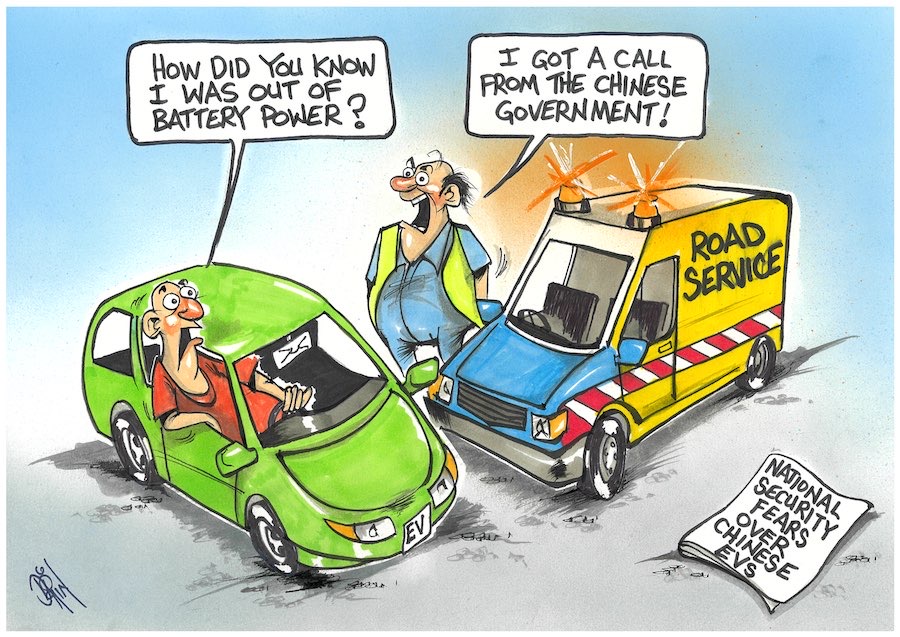
Letter writer BARRIE VIRTUE says that the carillon website indicates no recitals are being presented because of renovations. The website also indicates that COVID-19 is “delaying many of the works under way at the carillon”. What works?
PAUL Costigan’s column about the National Capital Authority (“What stops the NCA from doing a good job?”, CN February 9) has prompted me to ask what has happened to the National Carillon, which is managed by the NCA.
It seems to have gone quiet in the last couple of years or so. In fact, my wife and I on two occasions in the last six months have sat in our car with the windows and doors open in the car park just across from the bridge to Queen Elizabeth II Island and could barely hear the bells as a carillonist was practising. We gave up and went home.
I understand a large new bell was cast in – and brought from – England some time ago to be added to the existing bells but, as far as I know, that bell has never been heard. Why is that?
The carillon website indicates that no recitals are being presented because the carillon is closed for renovations. The website also indicates that COVID-19 is “delaying many of the works under way at the carillon”. What works?
Barrie Virtue, Hughes

A sad face of Turkey today

IT is true we have a significant number of issues to be concerned about in our city of Canberra. Nevertheless, I think it is a positive thing to think about the less fortunate here and in Ukraine and in Turkey.
Regarding the terrible earthquake in Turkey, I constantly keep in mind my friend in Hatay. He has lost everything in this event – his home, possessions, his work and he has just moved from living on the streets with his family to his new home, a moderate-sized tent.
The tent accommodates my friend, his wife, four children aged from six months to seven years and, in addition, he has taken in his aged mother and nephew with a leg deformity. Sadly, this is the face of a part of Turkey today.
Ross Bridge, Florey
Looking to find the ‘Missing Middle’
THE Missing Middle, what a great name for an association of developers, rent seekers, apparatchiks and handout merchants. Possibly the same marketing company that came up with the Trumpian “Greater Canberra”.
If they think there’s a “missing middle” go for a wander into any development built in the last 20 years and that’s all you get – dual occupancies, townhouses, medium density unit complexes.
It’s your only choice and it’s not cheap. A few big houses stuffed on to a tiny block costing over a million.
Truth be known, even the older suburbs have plenty of examples of duplexes, apartments and dual occupancies.
This group of vested interests is looking for business development opportunities and to cannibalise the existing RZ1 low-density Garden City areas. They don’t give a stuff about existing homeowners or community facilities. These zoning changes don’t do anything for retaining amenity, affordable housing or the environment.
You simply have to compare the aerial photos of an existing RZ1 suburb with detached houses, garages, gardens and trees and the new denser suburbs to see the impact of up-zoning. There’s no space for gardens, cars, trailers, boats or caravans. Has the Australian dream become too expensive?
If the government was so interested in affordable housing or environmental sustainability why didn’t they retain some of the large public housing estates in the inner north and south to demonstrate what was possible?
Ian Hubbard, via email
What has Senator Price brought to the table?
ERIC Hunter (Letters, CN March 2) can be trusted to look at something with his left-wing glasses on while ignoring the facts.
He questions what good has Senator Jacinta Price brought to the table. Considering Jacinta is indigenous herself and was the former mayor of Alice Springs with its high indigenous population, I would say she brings a whole wealth of knowledge and experience to the Voice vote.
While Prime Minister Anthony Albanese finds time for three days at the Australian Open tennis in Melbourne and, more recently, marching in the Sydney Mardi Gras and across the Harbour Bridge, he could only spend a small few hours in troubled Alice Springs listening to and seeing the troubles going on there with the mainly indigenous population.
As we have seen from both sides of politics, indigenous people have very differing views of the Voice, so it would be racist to think that all Aboriginal people think and vote the same.
For the federal government to offer tax concessions to organisations that promote the “yes” vote is both undemocratic and racist. If we are to vote in a democratic way, why is the Albanese government offering incentives to sway one side of the vote. Not very democratic at all.
Ian Pilsner, Watson
Questions about the Voice
AN examination of the media shows a level of comment higher on this than on any other single issue in recent times. It suggests a disquiet across population groups.
I feel answers to all of the following need to be known before any referendum:
- What will be the fully declared cost of a “yes” vote to the taxpayer?
- Will salaries be paid to indigenous Voice appointees and at what levels and superannuation entitlements?
- What other benefits will be paid to or conditions received by indigenous Voice appointees?
- What safeguards will be put in place to ensure indigenous appointees’ salaries/conditions do not fall behind their political partners?
John Lawrence via email
Ministers should ‘come clean’ on planning
WHEN wearing its developer hat, the ACT government has again shown it can’t be trusted to show leadership and be a good role model in our current planning and urban renewal environment (“Housing ACT loses another ‘wasteful’ Griffith DA”, citynews.com.au, March 3).
Yet it blithely pushes on with a new and complex “outcomes” focused set of planning reforms, without explaining or illustrating exactly how current “outcome” deficiencies in any of the private or public housing plans it ticks now will be avoided in the future.
In order to inspire far more trust and confidence in the government’s new planning regime, the planning and housing ministers need to come clean with the public.
We need to know how they will be vastly be improving not only their own planning approaches and design and quality standards for the development of the ACT’s future public housing assets and also ensuring far better outcomes for all social, affordable and build-to-rent projects that the reform documentation prioritises as part of the government’s infill vision for many established suburbs.
How will ACT government housing policy and tender processes be revamped and resourced to deliver higher-quality and long-lasting built forms, landscaping and setting “outcomes”, for housing that everyone can be proud of?
Well before the new planning regime is finalised, both ministers could share with the public the lessons learned from numerous ACAT reviews and decision making on development applications, as one helpful means of injecting more transparency into what needs to change for the better under the new planning system.
Sue Dyer, Downer
Talk to the community about growth
ACT Treasury observes caution should be exercised in the use of population projections which “should not be interpreted as precise predictions of demographic future, but instead provide an indication of population change.”
The current projection projecting an ACT population of 784,000 in 2060 is the outcome of expectations about natural increase and migration that may or may not be realised.
I am reminded of the 2003 population projections that, based on growth expectations of the time, projected the population of Canberra would peak at 388,000 in 2031. Its adoption contributed to school closures.
The low growth during covid indicates the level of uncertainty in projecting population growth.
Underlying the estimates of growth by location are unspecified assumptions about the scope for development and redevelopment which, at best, are based on limited assessments of housing preferences, infrastructure capacity, infrastructure costs, development impact (privacy, noise, congestion, solar access, tree cover) and development potential (eg, no development in Kowen and west Murrumbidgee. Why?).
The projections of growth are not set in stone. The assumptions made should be made explicit and discussed with the community in the quest to determine how the future growth of the city is best managed.
Mike Quirk, Garran
Bring back common sense, please
SUCCESSIVE gutless governments of all political persuasions by pandering to minority groups for crass political purposes, has led to “political correctness” taking over from common sense.
This disgraceful state of affairs has been very aptly described as “when intelligent people are being silenced, so that stupid people won’t be offended”. When and where will it all end?
Mario Stivala, Belconnen
Who can be trusted?
In a world of spin and confusion, there’s never been a more important time to support independent journalism in Canberra.
If you trust our work online and want to enforce the power of independent voices, I invite you to make a small contribution.
Every dollar of support is invested back into our journalism to help keep citynews.com.au strong and free.
Thank you,
Ian Meikle, editor





Leave a Reply